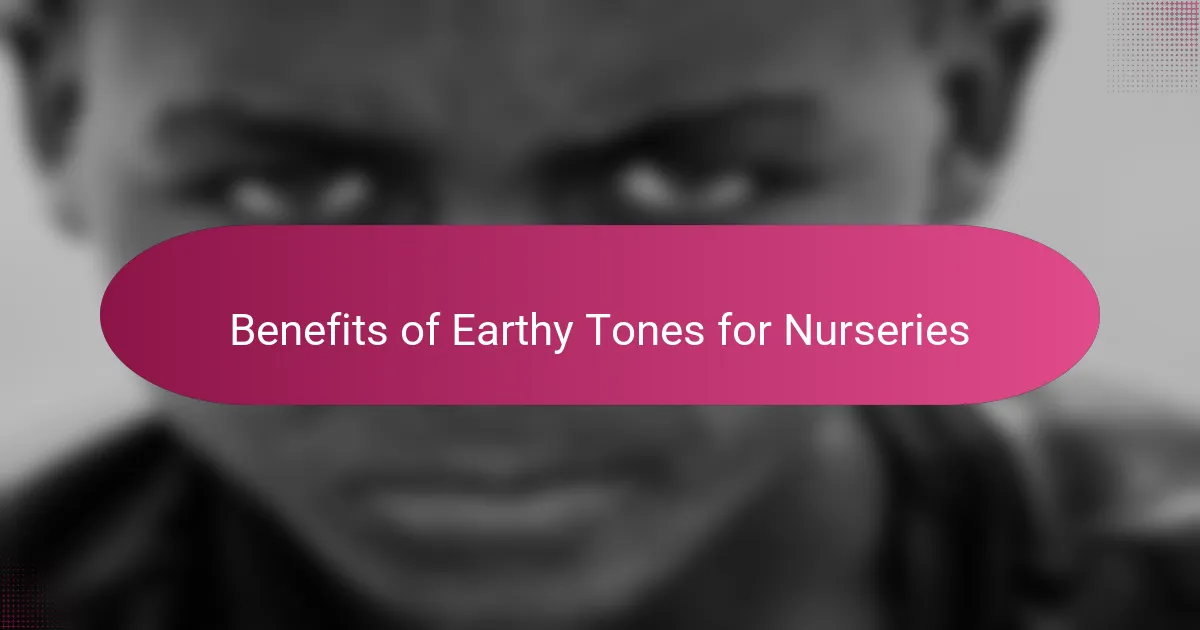Key takeaways
- Earthy tones create a calming and nurturing atmosphere in nurseries, promoting well-being for both parents and babies.
- Functionality and comfort are essential in modern nursery design, balancing aesthetics with practical storage solutions and cozy textures.
- Choosing soft, neutral colors helps establish a peaceful environment that evolves with the child over time, avoiding trends that may quickly feel outdated.
- Incorporating natural textures and careful lighting enhances earthy tones, creating a warm and inviting space that fosters exploration and comfort.

Understanding Earthy Tones in Design
Earthy tones are those warm, muted colors inspired by nature—think soft browns, gentle greens, and cozy beiges. From my experience, these shades instantly bring a sense of calm and groundedness to a room, which is something I personally value when designing any space. Have you ever noticed how just a touch of these colors can make a nursery feel so inviting and peaceful?
What strikes me most about earthy tones is their versatility. They don’t scream for attention but rather whisper comfort, allowing other design elements to shine without overwhelming the senses. When I used them in a nursery project, the parents told me how the space felt nurturing and balanced, which I found incredibly rewarding.
I often wonder, why do we crave these natural hues in the first place? Maybe it’s because earthy tones subtly connect us back to the outdoors, even when we’re indoors. To me, this connection is vital—it grounds the room and those who live in it, creating a subtle but powerful sense of well-being that’s perfect for a child’s environment.

Basics of Modern Nursery Design
When I think about the basics of modern nursery design, functionality immediately comes to mind. A nursery isn’t just a beautiful space; it should also be practical. For instance, I always prioritize storage solutions that keep toys and essentials within easy reach while maintaining a clean, uncluttered look.
Another core principle I find essential is balancing aesthetics with comfort. Soft textures and ergonomic furniture can transform a nursery from merely attractive to truly cozy. Do you remember how it felt curling up in your childhood room? That sense of security is something I strive to recreate through thoughtful design.
Lighting also plays a surprisingly big role in modern nurseries. Natural light, when harnessed correctly, can brighten a room and enhance those gentle earthy tones. I recall one project where simply adjusting the window coverings made the room feel warmer and more inviting, proving that small tweaks can make a huge difference.

Benefits of Earthy Tones for Nurseries
There’s something about earthy tones that instantly soothes the restless energy of a nursery. From my experience, these colors create a cozy and nurturing atmosphere that feels like a gentle hug for both baby and parents. Have you ever walked into a room where the colors just seem to whisper calm? That’s exactly what earthy tones do—they ease tension and foster peaceful moments.
I remember designing a nursery drenched in soft taupes and mossy greens where the parents remarked how their baby seemed calmer during bedtime. It’s no surprise to me because these hues help regulate mood by reducing overstimulation, which is so important in those early months. Plus, they age beautifully, meaning the room can grow with the child without feeling dated or too juvenile.
What I also appreciate is how earthy tones naturally complement other textures and materials—wood, linen, rattan—adding layers of warmth and depth. This mix sparks a tactile experience that encourages exploration and comfort. Don’t you think a room that feels grounded and inviting sets the stage for a child’s sense of security and curiosity? I certainly do.

Choosing Earthy Colors for Nurseries
When choosing earthy colors for nurseries, I’ve found that starting with a soft, neutral base can really set a peaceful tone without overwhelming the space. Have you ever noticed how a gentle beige or warm taupe instantly feels like a warm embrace? It’s these subtle shades that make me feel the room is ready to welcome a little one with calm and comfort.
One thing I always consider is how these colors change throughout the day. Natural light can make a muted olive or sandy brown appear more vibrant or soothing depending on the time, which I think adds a lovely dynamic to the nursery’s atmosphere. When I last used a deep clay shade, it surprised me how much it added cozy depth without making the room feel dark or confined.
Choosing earthy tones also means thinking about longevity. I tend to pick colors that grow with the child—nothing too bold or trendy that might feel out of place in a few years. Isn’t it nice to imagine a nursery that evolves gracefully, carrying sentimental value while still feeling fresh and relevant? That’s the beauty I see in earthy palettes for these special spaces.

Personal Opinion on Olympic’s Earthy Tones
Olympic’s earthy tones immediately resonate with me because they feel so genuine and grounding—like nature’s own palette carefully curated for our living spaces. When I first worked with these shades, I noticed how effortlessly they brought a warmth that modern, brighter colors sometimes lack. Have you ever felt that pull towards something natural that just feels right? That’s exactly the effect these tones have.
I also appreciate how Olympic’s earthy colors offer subtle complexity without being loud. In one nursery project, using their muted greens and soft browns created a serene backdrop that made every other design detail pop without competing for attention. It felt like the room was breathing calmness, which to me is invaluable when designing for little ones.
What surprises me most is how timeless these tones are. I recall a client telling me how the earthy hues didn’t just work for the nursery stage but seamlessly transitioned into a toddler’s room with ease. Isn’t that the kind of thoughtful design we all want? Olympic’s earthy tones prove that simplicity and longevity can beautifully coexist.

Practical Tips for Using Earthy Tones
One tip I swear by when using earthy tones in a nursery is to layer different shades rather than sticking to just one color. For example, pairing a soft sand with deeper terracotta accents can add depth and warmth without feeling flat. Have you ever noticed how a simple mix like that makes the room feel alive yet soothing? It’s those subtle contrasts that really create a balanced atmosphere.
Another practical approach I like is incorporating natural textures alongside these tones. Think about adding rattan baskets, linen curtains, or wooden furniture to complement the earthy palette. From my experience, these textures don’t just enhance the colors—they invite touch and make the space feel cozy and connected to nature, which is so important for a nursery.
Lastly, I always suggest considering lighting carefully when working with earthy hues. Natural light can transform a muted green or warm brown from dull to vibrant throughout the day. Have you ever been in a room where the sunlight seems to dance on the walls? That dynamic shift keeps the nursery feeling fresh and comforting, something I’ve found truly valuable in my designs.

Final Thoughts on Earthy Tones in Nurseries
When I reflect on earthy tones in nurseries, what stands out most is their remarkable ability to create a sanctuary-like space. Isn’t it fascinating how these muted colors don’t just decorate a room but actually foster a deep sense of calm and security? From my experience, that quiet reassurance is invaluable in a place meant for little ones to grow and rest.
I’ve noticed that earthy tones also offer a timeless charm that few other palettes can match. Designing nurseries with these colors feels like giving children a gentle gift—a backdrop that evolves with them without ever feeling outdated or overwhelming. Have you ever walked into a nursery and sensed that perfect balance of warmth and stability? To me, that’s exactly what earthy hues deliver so effortlessly.
Ultimately, choosing earthy tones is about more than aesthetics; it’s about crafting an environment that nurtures well-being. I think about how a softly layered palette can wrap a child in comfort every day, quietly supporting their journey from infancy onward. Doesn’t that possibility make these tones feel not just beautiful, but profoundly meaningful?
